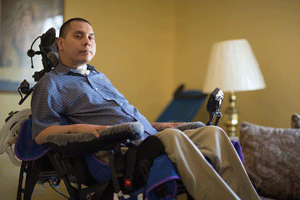Mario Zapata
 The bullet that tore through Mario Zapata’s flesh lodged high in his cervical spinal cord and left him immediately paralyzed from the neck down. The metal fragments damaged his C3, C4 and C5 cervical vertebrae – the ones responsible for controlling the diaphragm and allowing the body to breathe on its own. He was placed on a ventilator, and for three years, that was how his body breathed.
The bullet that tore through Mario Zapata’s flesh lodged high in his cervical spinal cord and left him immediately paralyzed from the neck down. The metal fragments damaged his C3, C4 and C5 cervical vertebrae – the ones responsible for controlling the diaphragm and allowing the body to breathe on its own. He was placed on a ventilator, and for three years, that was how his body breathed.
“There are so many feelings that go along with an injury like this,” Mario, 28, says. “I’ve thought a lot about how my life has changed. I used to get upset thinking about all the things I’ve lost, and I’d get discouraged because I can’t even breathe on my own.”
And then one day Mario was surfing the internet. “For some reason I was watching a YouTube video on cardiac pacemakers, and the next video that popped up was a pacemaker for the diaphragm,” he says. The diaphragmatic pacing system by Synapse Biomedical was approved by the FDA in 2008 for ventilator- dependent spinal cord injury patients who lack voluntary control of their diaphragm.
“Every time I had an appointment with my pulmonologist, I would ask him if I’d ever breathe on my own again. He told me there was a very low possibility, and I had already accepted that answer, but my mom never did. She kept wanting me to ask.”
So on his next visit, Mario asked the question again. And this time pulmonologist Gregory Ahearn, MD, brought cardiothoracic surgeon Elbert Kuo, MD, MPH, MMS, into the room.
“Dr. Kuo asked me if I had ever heard of diaphragmatic pacing. I told him about what I found on YouTube, and together, the doctors said I seemed like the perfect candidate for it. They took some x-rays and told me they’d get back with me in a couple of days. I was scheduled for surgery on April 23.”